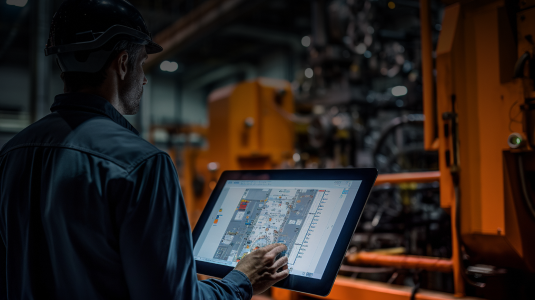Table of Contents

Due to the rapid advancements in artificial intelligence and machine learning, the use of AI-powered radiology tools has become popular in the field of diagnostic imaging. It can quickly process large amounts of image data and detect subtle patterns and anomalies. The use of AI in radiology can help to improve diagnostic accuracy, streamline the workflow of doctors, and help to enhance patient outcomes.
The integration of AI in radiology is helping companies to change their approach to healthcare technology, exploring new opportunities related to treatment planning and ensuring personalized patient management.
As per a report, the global AI medical imaging market was valued at $0.98 billion last year and is projected to grow to around $11.76 billion, with a CAGR of 28.19% between 2023-2033. This impressive growth highlights the scope for startups as well as established companies in the healthcare domain to develop effective AI solutions to boost patient care in radiology.
Moreover, as the need for efficiency and precision in the healthcare industry grows, the demand for AI-driven radiology software and apps will also rise. Entrepreneurs who can navigate this area well, have a clear understanding of radiologists and deliver customized AI solutions are likely to make valuable contributions to the field and grow in this expanding market.
Want Your Hospital To Harness The Power of AI analytics And Automating Processes? We Help Hospitals Perform Accurate Diagnoses With Our Artificial Intelligence Solutions.
How AI is Boosting Efficiency in Diagnostic Imaging?
The rise of AI in radiology is enhancing the effectiveness of medical diagnostics, bringing remarkable efficiency in accuracy, quicker diagnosis times, and better patient results. This technology is helping to detect diseases accurately, enabling interventions to be done at the early stages.

Radiologists can now use AI tools to analyze vast volumes of imaging data in a short span of time and track patterns that are often missed by the human eye. This improves the diagnostic process and also reduces the probability of errors, ensuring a more reliable healthcare system.
A report shared by John Hopkins Medicine shows that the use of AI in radiology significantly helps to automate tasks, improve diagnostic accuracy and patient care by helping radiologists in their work process.
This advancement also matches global trends as AI has become a vital aspect of medical imaging, enhancing overflows and the capabilities of healthcare providers. It’s time that companies in the healthcare domain recognize the effectiveness of radiology in offering better quality treatment.
By investing in AI technologies, organizations can automate complicated diagnostics tasks, improve accuracy, and streamline operations. This proactive approach can help them not only to be updated with the latest innovations in the healthcare domain but also to perform the treatment of patients with precision.
5 Benefits of Using AI in Radiology
AI transforms diagnostic processes and helps to boost efficiency. Understanding the benefits of using AI in radiology highlights these enhancements. The 5 key advantages are explained below:
Higher Accuracy and Precision
AI greatly helps to improve the precision of medical assessments. This improvement stems from applying AI in radiology, which reduces human error. Improved diagnostic accuracy ensures more effective treatments. This technology can streamline the interpretation of successful images, thereby ensuring reliable results. A high level of precision is essential for treating patients successfully.
Significant Cost Reduction
AI technologies help to streamline radiological operations, ensuring substantial cost savings. By integrating AI into radiology, you can automate repetitive tasks. Moreover, AI in radiology also reduces the need to perform repeated scans. This efficiency helps in minimizing operational costs and enhancing resource allocation. So, clinics and hospitals can lower their expenses and improve the overall quality of healthcare.

Better Efficiency and Speed
The integration of AI in radiology helps to greatly reduce the time required for diagnostic processes, improving overall efficiency. With quicker image processing and analysis as major benefits, AI usage in radiology reduces the workload of radiologists, ensuring quicker, better results.
Access to the Latest Research Facilities
AI offers access to new innovations in the field of radiological research, improving the development of novel diagnostic techniques. With the integration of AI in radiology software, researchers can gain access to more accurate data quickly. This capability speeds up the innovation of new tools and diagnostic methods.
Moreover, improved research facilities enhance the understanding of complex medical treatments, enabling rapid advancements in the field of radiology.
Personalized Planning of Treatments
AI can integrate and analyze diverse data sources that extend beyond image analysis to genetic information, electronic health records (EHR), and patient history. AI helps to blend this data and helps to develop personalized treatment plans tailored as per needs of patients.
For instance, in oncology, AI can analyze imaging data along with generic markers and treatment response patterns that recommend the most effective therapy for a specific cancer subtype. Moreover, AI can use predictive analytics for forecasting disease progression.
It can help doctors identify which patients are more vulnerable to the risks of recurrence or complications, enabling them to execute proactive measures and monitor patients closely. This personalized approach improves the precision of medical care.
Want to tap the booming radiology app development? Count on our Healthcare Software Development Services that will add an edge to your business growth
What are the Challenges of Using AI in Radiology?
AI undoubtedly helps to boost the working efficiency of clinics and hospitals. However, AI methods and tools do have some shortcomings as well. Some of these are:
1. Lack of Standardization
Martin-Valdivia and Luna have presented a SWOT analysis for AI in the domain of medical imaging. They have highlighted the lack of standardization as a potential weakness of AI in radiology. The lack of standardized benchmarks makes it tough to compare or assess the performance of any model. Without validation, it is tough to decide whether a model is ready for implementation or not.
2. Lack of Explanation
The researchers further found that model explainability is a threat as a major threat of AI in medical science. An AI algorithm’s interpretability is essential for clinical data science. Deep learning algorithms execute a neural network architecture and process data sets via several thousand neurons.
Humans can’t acquire concrete logic behind this complex mathematics. The lack of reasoning raises questions related to the reliability of AI models. AI interoperability becomes more essential in clinical integration because the slightest mistake can have negative consequences. For people to trust AI-powered detections and decisions, some reasoning is required.

Are You Ready to Deploy AI in Radiology?
Talk to the Experts of Hidden Brains Today3. Lack of Validation Datasets
The effectiveness of AI in radiology to a great extent depends on the availability of patient data. Generating validation data sets takes time which acts as a roadblock to numerous machine learning projects. But, AI models can’t be tested for modern applications without these data sets.
4. Breach of Privacy
One major concern is the fact that medical researchers have access to the personal records of patients for training models. This has raised doubts in the minds of people who value their privacy and are not in favor of integrating AI into radiology.
The correct use of data, data privacy, and data biases all fall under the purview of the ethics of AI. Ethics are vital to ensure that medical researchers cause no harm to patients while practicing AI. Let’s explain this in detail in the next section.
Ethics Related To AI In Radiology
Ethics plays a vital role in AI, especially in the healthcare domain. The main purpose of AI is to make decisions without any sort of human intervention. It applies complex logic, and that is where the problems crop up.
Many patients won’t like medical decisions based on mathematical calculations from AI algorithms. The European Society of Radiology reports, “We must ensure that radiological AI remains human-centric, helps patients, contributes to the common good, and evenly distributes both the benefits and harms that may occur.”
As practitioners, radiologists can gain access to the records of their patients. They can easily use this data for identity theft, enabling the thief to commit insurance fraud and obtain prescription drugs illegally. As highlighted by Brady and Neri in 2020, radiologists are responsible for making sure that the patient data is used only for the welfare of patients and clinical practice.
The responsible usage of radiology data sets also means that radiologists need to take care of any biases. Biases harm the patient population based on gender, ethnicity, or race. While creating a medical dataset, it’s not possible to include patients from all ethnicities.
When models trained on this type of data are implemented, they generate inaccurate results for the population missing in the training data set. The responsibility for generating unbiased data is on data scientists who use machine learning applications.
How AI is Applied in Radiology?
AI in radiology is applied via advanced image analysis algorithms that help to detect and classify abnormalities in medical scans, like MRIs, X-rays, and CT scans. It also optimizes workflow efficiency of hospitals and clinics by automating routine tasks, enabling radiologists to focus on critical cases and enhance overall diagnostic accuracy.
Here are some areas of radiology where AI can be used effectively:
Classification of Brain Tumors
The traditional treatment of brain tumors is highly time-consuming. Classifying the tumor takes around 40 minutes, and only after that, a doctor can decide on the course of action for further treatment. You can use MRI images and machine learning to identify brain tumors. You will get a satisfactory result in just a few minutes. Precise data annotation is needed to achieve accurate results.
A recent report utilizing CNNs with MRI scans as the input image got an accuracy of 98.56 in classifying different types of brain tumors. Another AI-based research in the UK has discovered a non-invasive technique for classifying tumors in children.
The researchers utilized the diffusion of water molecules for abstaining contrast in MRI scans. Later, the detectable diffusion map is extracted and fed to an AI model.
Having A Tough Time Finding A Dedicated Software Development Team? Talk To Our Experts Today
Detecting Neurological Abnormalities
Neurological disorders occur when specific parts of the brain stop functioning in a proper way. These parts are mainly responsible for memory & speech and are vulnerable to diseases such as Parkinson’s and Alzheimer’s. Utilizing convolutional neural networks, AI can extract useful details from brain image data.
This information helps to detect irregular brain development. Research at Mount Sinai Health Systems has shown that novel AI techniques can be utilized to detect the cause of Alzheimer’s. The researchers analyzed human brain images by using deep learning techniques and also monitored stain intensity. Researchers can also detect these diseases by tracking the retinal movements of their patients.
Breast Cancer Detection
Breast cancer detection is done through a careful examination of the mammography report, ultrasound, or MRI scan. The manual verification process has a risk of human error, and misdiagnosis happens often. AI tools can improve mammography examinations.
AI tools can improve mammography examinations. A study published in the Radiology Society of North America (RSNA) aimed at detecting the risk of breast cancer by examining mammograms. 87.6% of these screen-detected cancers scored the greatest risk.
The researchers concluded their findings by stating, “In our study, we assumed that all cancer cases selected by the AI system were detected. This might not be true in a real screening setting. However, given that assumption, AI will probably be of great value in the interpretation of screening mammograms in the future.”
Radiation Dosage Optimization
This user case is different from the others we have discussed above. While undergoing radiology tests, a patient gets exposed to harmful radiation to acquire an accurate MRI or CT scan. Radiologists need medical images to differentiate anomalies. The longer the patient remains exposed, the better would be the image quality. Adults can bear the discomfort, but it might harm children.

What is the Future of AI in Radiology?
There is a lot of concern related to AI and its future impact related to medicine. Many indications suggest that AI will completely transform the healthcare domain. Because of rapid developments in deep learning and narrow AI, there is a lot of concern about job security among radiologists.
According to Curtis Langlots, Professor of Radiology, radiology is not a dying profession. As a comparison, you can consider a plane going into autopilot mode. The innovation didn’t replace pilots but assisted in their tasks. When a plane flies on a long route, it’s a great idea to have a switch on autopilot mode.
However, they are not very useful when a quick decision needs to be taken. So, a collaboration of technology and humans is the most effective one. The same applies to the healthcare domain. AI won’t be diagnosing patients, replacing radiologists.
Instead, it will enhance their ability to find key, relevant data they require to care for a patient and present it in a clear format that is easy to understand. Once a doctor asks a CT scan to read, the AI will review the image and also track the possible findings immediately.
From the image and going through the patient history related to the specific anatomy scanned. If the exam case order is for chest pain, the AI system will call up.
Conclusion
In conclusion, AI is bringing a new era in radiology, marketed by unparalleled accuracy and improved patient care. By using advanced algorithms to analyze medical images and automate routine tasks, AI enables radiologists to make more precise diagnosis and focus on complex cases. As AI technology is evolving, its integration into radiology will drive further innovations and set new benchmarks in the domain. We hope that you have understood AI in Radiology concept and now you must Hire Developers to build effective web and mobile applications. These will help in enhancing business efficiency and to provide an ultimate patient care.
How Hidden Brains Can Help to Implement AI in Radiology?
To perform radiology tests accurately, MRI and CT scans need to be performed with precision. AI can ensure accurate diagnosis, and simplify the work of radiologists, helping them to ensure personalized care of their patients.
At Hidden Brains, we have a team of technical experts who have ample knowledge and expertise to create AI solutions that match your needs perfectly. We will help you through the implementation process.
FAQs
In this blog, we have highlighted the pros, cons, and areas of radiology where AI can be applied. To know more, you can refer to the FAQs below:
What Specific Benefits Does AI Provide in Detecting Early-Stage Diseases in Radiology?
AI can help users detect subtle patterns and anomalies in medical images that are otherwise overlooked by radiologists, ensuring early detection of diseases like cancer. Early detection can help to improve a patient’s chances of survival.
How Does AI Help in Optimizing the Workflow of Radiology Departments?
AI automates routine tasks such as image screening and preliminary reporting, minimizing the workload of radiologists. It helps to prioritize urgent cases by analyzing images and flagging important findings, to ensure timely diagnosis and treatment.
How Does AI Enhance the Accuracy of Radiological Diagnosis?
AI algorithms are trained on vast datasets and they can detect minute details in images, minimizing the likelihood of human error. This ensures more accurate, consistent diagnosis, enhancing the quality of patient care.
What are the Possible Ethical Concerns Related to AI in Radiology?
Possible ethical concerns include data privacy issues, biases in AI algorithms which may cause unequal treatment, and the need for accountability when AI systems are utilized for clinical decision-making.
In Which Areas of Radiology is AI Currently Being Used Effectively?
AI is highly effective in mammography for detecting breast cancer, chest imaging for identifying pneumonia and other lung infections, and neuroimaging for detecting brain tumors and neurological disorders.









































